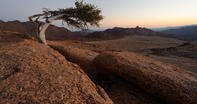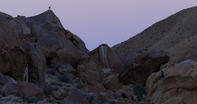The Missionary’s Position
The so called ‘Hottentots’ and Bushmen were written off by the newly arriving Europeans as Godless heathens and inveterate sinners. However, the same thing could be said for many of the Europeans who lived at the Cape in the early days of the colony.

Van Riebeeck himself warned his colleagues that those who "absent themselves from daily prayer ... attending very little to their religion …(are) warned henceforth to attend at the place appointed for the purpose, ... those remaining absent shall forfeit six days wine rations...".
In those days, the Company followed the Protestant Dutch Reformed Church of Holland, and the first minister, Johan van Arkel, arrived at the Cape in 1665, more than 10 years after the settlement was established. Roman Catholics and German Lutherans were not permitted to practise, and even the ideologically similar French Huguenots were initially restricted in their worship.
Spiritual Beliefs
Over the next few decades, very few Khoikhoi or Bushmen were converted to the Christian cause. But this is not to say that the locals were without religion. They just weren’t particularly interested in what happened to their souls in the here-after. Instead, spiritual beliefs were organised around practical matters, such as the need for rain, healing of sickness, the fertility of crops, the plenitude of animals and general matters of day-to-day survival.
The Bushmen, for example, believed in a number of ‘gods’ with the creator/Kaggen being the supreme deity. The Khoikhoi, for their part, worshipped Tsui//Goab, the supreme God, who was offset against/Guanab, the god of evil.
For both groups, the ancestors (spirits of deceased relatives) provided a link between the living and the gods (who were often depicted as half-human and half-animal). Shamanistic rituals, trance dances and hallucinogenic plants were a recurring feature of their religious practises.
The Faithful
The first exploratory missionary trip through Namaqualand was thus made by Christian Albrecht in 1805. Later that same year, he and his brother Abraham established a mission among the Great Namaqua at Warmbad (in present-day Namibia), assisted by J. Seidenfaden.
In 1811, however, Abraham died from tuberculosis, and the mission was sacked by the boisterous chief Jager Afrikaner. The faithful then fled south into the eastern reaches of Namaqualand, on the western border of what is now known as Bushmanland. Here, they determinedly opened a new mission at Pella (near the modern village of Pofadder).
The LMS and other ‘Lutherans’ continued to make in-roads throughout Namaqualand. In 1813, the Rev. John Campbell called at Pella, and a German missionary, Christopher Sass, opened a mission at Silwerfontein. In 1815 the Rev J.H. Schmelen established the Bethanien mission in Namibia.
In 1816, Rev Barnabas Shaw was invited to set up a Wesleyan mission at Leliefontein, on a farm which had been given to the indigenous people by Governor Ryk Tulbagh in the mid-1700s. This was done at the behest of Chief Haaimaap, otherwise known as Jantje Wildschut (Johnny Wildshot). In 1818, Rev. Schlemen travelled to Kookfontein (also known as Kokfontein or Besondermied) and established a mission station there, naming it Steinkopf in honour of his mentor and teacher in London. He also founded a mission at Kommagas.
The Fate of Pella

Soon, the Rhenish Mission Society got in on the act and, in 1830, one of their inspectors, Dr E. Richter, visited the far north-west of Namaqualand to inspect this remote region. A mission station was subsequently established at Kuboes in the mid-1800s as a ‘sub-station’ of the Steinkopf mission.
The population at Kuboes was a mixture of Nama and Bastaards, and the entire region came to be known as the Richtersveld in honour of the good doctor’s visit. In 1852, the Rhenish Church (meaning from the Rhine River) also established the Concordia mission, very close to Springbok.
By David Fleminger